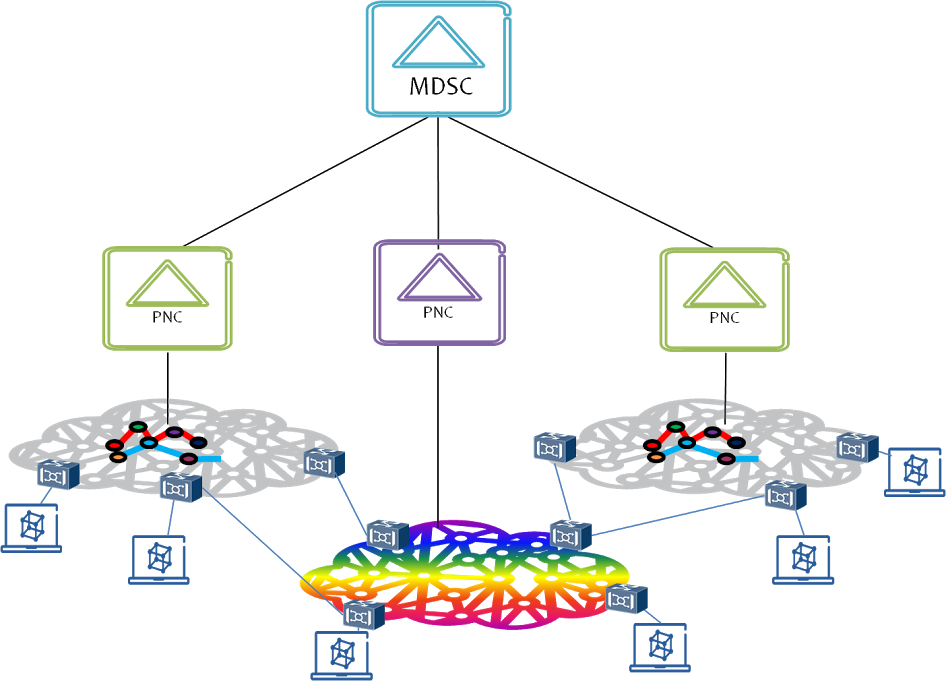...
- Adaptation of customer requests (made on virtual resources) to
the physical network resources performing the necessary
mapping, translation, isolation and, policy that allows
conveying, managing and enforcing customer policies with
respect to the servicesby theservicesby the network to said customer.
- Provision of a computationscheme and computationschemeand virtual control
capability via a data model to customers who request virtual
network services. Note that these customers could, themselves,
be service providers.
ACTN solutions buildson, and extend, existing TE constructs and
TE mechanisms wherever possible and appropriate.
Framework
. CNC - Customer Network Controller . MDSC - Multi Domain Service Coordinator . PNC - Physical Network Controller
Customer Network Controller
A Virtual Network Service is instantiated by the Customer Network
Controller via the CMI (CNC-MDSC Interface). As the Customer Network
Controller directly interfaces the application stratum, it
understands multiple application requirements and their service
needs. It is assumed that the Customer Network Controller and the
MDSC have a common knowledge on the end-point interfaces based on
their business negotiation prior to service instantiation. End-point
interfaces refer to customer-network physical interfaces that
connect customer premise equipment to network provider equipment.
In addition to abstract networks, ACTN allows to provide the CNC
with services. Example of services include connectivity between one
of the customer's end points with a given set of resources in a data
center from the service provider.
Multi Domain Service Coordinator
The MDSC (Multi Domain Service Coordinator) sits between the CNC
(the one issuing connectivity requests) and the PNCs (Physical
Network Controllersr - the ones managing the physical network
resources). The MDSC can be collocated with the PNC, especially in
those cases where the service provider and the network provi
der are the same entity.
The MDSC isthe only building block of the architecture that is a
ble to implement all the four ACTN main functionalities, i.e. multi
domain coordination function, virtualization/abstraction function,
customer mapping function and virtual service coordination. The key
point of the MDSC and the whole ACTN framework is detaching the
network and service control from underlying technology and help
customer express the network as desired by business needs. The MDSC
envelopes the instantiation of right technology and network control
to meet business criteria. In essence it controls and manages the
primitives to achieve functionalities as desired by CNC
A hierarchy of MDSCs can be foreseen for scalability and
administrative choices. In order to allow for a hierarchy of MDSC,
the interface between the parent MDSC and a child MDSC must be the
same as the interface between the MDSC and the PNC. This does not
introduce any complexity as it is transparent from the perspective
of the CNCs and the PNCs and it makes use of the same interface
model and its primitives as the CMI and MPI.
A key requirement for allowing recursion of MDSCs is that a single
interface needs to be defined both for the north and the south
bounds. In order to allow for multi-domain coordination a
1:N relationship must be allowed between MDSCs and between MDSCs and PNCs
(i.e. 1 parent MDSC and N child MDSC or 1 MDSC and N PNCs)
. In addition to that it could be possible to have also a M:1 relationship
between MDSC and PNC to allow for network resource partitioning/
sharing among different customers not necessarily connected to the
same MDSC (e.g. different service providers).
Physical Network Controller
The Physical Network Controller is the one in charge of configuring
the network elements, monitoring the physical topology of the
network and passing it, either raw or abstracted, to the MDSC.
The PNC, in addition to being in charge of controlling the physical
network, is able to implement two of the four ACTN main
functionalities: multi domain coordination function and
virtualization/abstraction function
A hierarchy of PNCs can be foreseen for scalability and
administrative choices.
